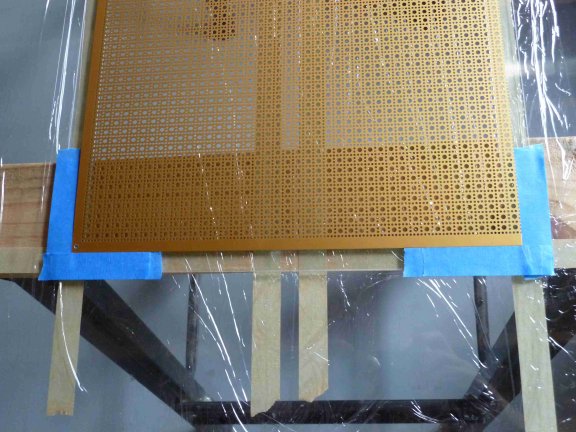There are several gluing steps required in ESL fabrication, at least if you follow the general instructions given by Roger Sanders - you need to glue each of the two stators onto plastic spacers, and you need to bond the diaphragm on both sides to the spacers. When I first started making ESLs, one of the difficulties I encountered was how to make sure that things lined up during gluing steps. In fact, things typically did not line up very well. So for example I would find that after I lowered a stator onto the spacers, it did not quite register so I would have to slide it into the correct position, smearing the glue around in the process.
I gave this problem some thought and came up with a simple and effective solution that has worked very well for me. The following photo illustrates the basic idea:

The photo illustrates the step where an aluminum stator is to be glued onto plastic spacers underneath. I first put the stator in the position where I want it to end up, without any glue on the spacers. With painters' masking tape, I make retaining corners around the bottom corners of the aluminum stator. It takes around four or five layers of tape before the corners are high enough to effectively locate the stator. You have to hold the tape so that it touches the stator edge before placing the tape on the spacer, in order to ensure that the layers of tape are properly placed. Once these corners are in place, I remove the stator and go through a couple of "dry runs" to make sure that I can lower the stator into the correct position.
Once I am convinced that the tape corners are locating the stator properly, I place the glue on the plastic spacers and use the corners as guides to lower the stator into position. The following photo illustrates the technique:

With the stator nearly vertical I first place its lower corners in the tape corners, then I slowly lower the stator while maintaining some force against the tape corners to keep the stator from shifting. By bending the stator it will first contact the glue at the bottom and then progressively toward the top. When the glue contact point is almost at the top, you can release the top of the stator so that you avoid ever touching the glue with your fingers. Using this technique I find that any misalignment after gluing is minimal and requires only a slight adjustment, and often no adjustment at all is required.
This same technique can be used when gluing a stator/spacer assembly down onto the diaphragm film. In that case, the tape corners are placed on the film surface.
Home